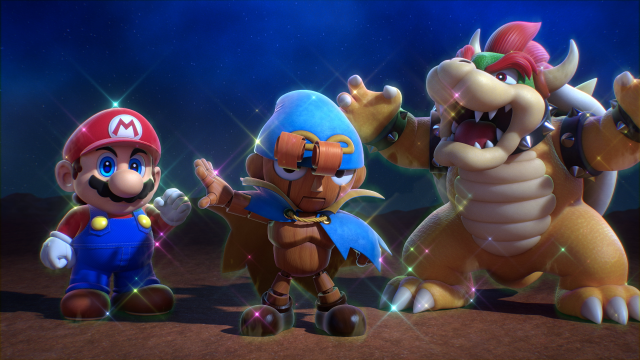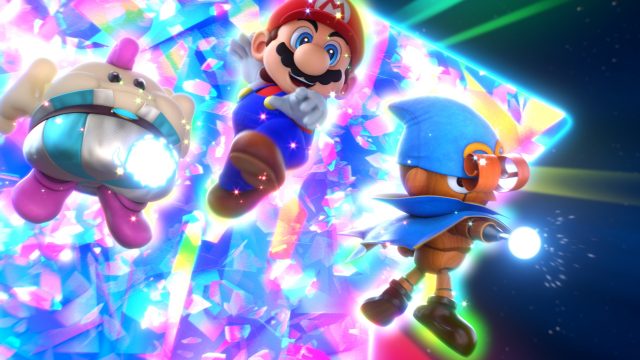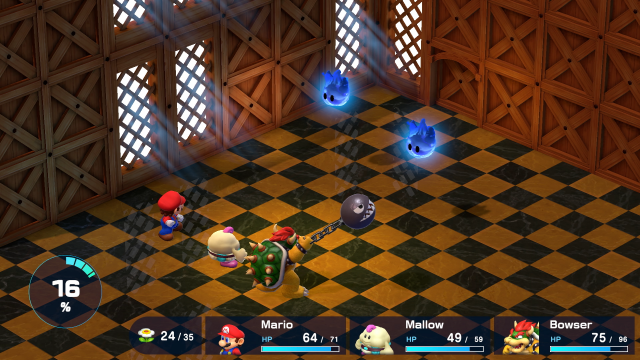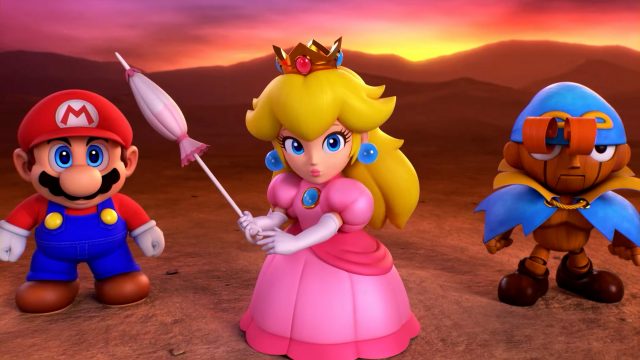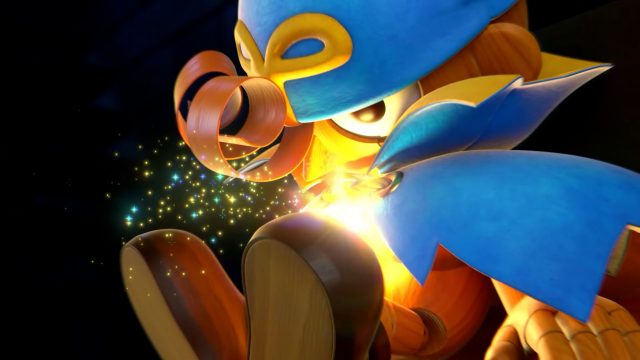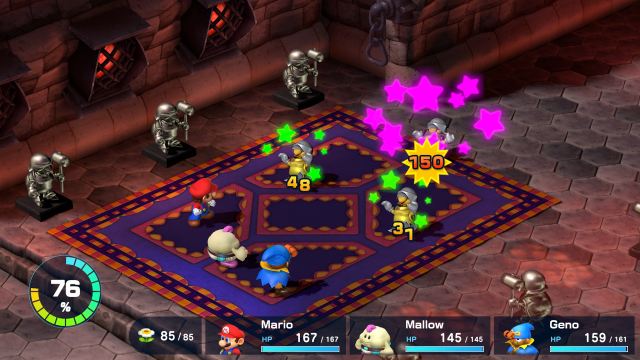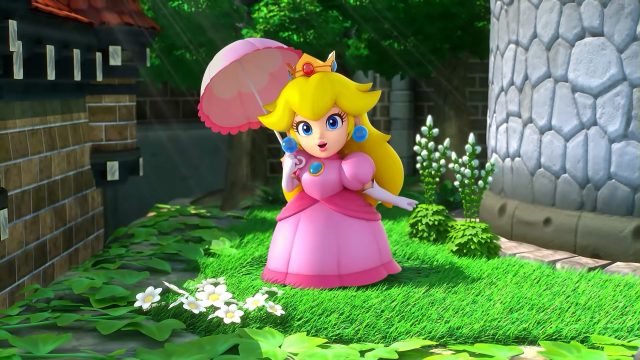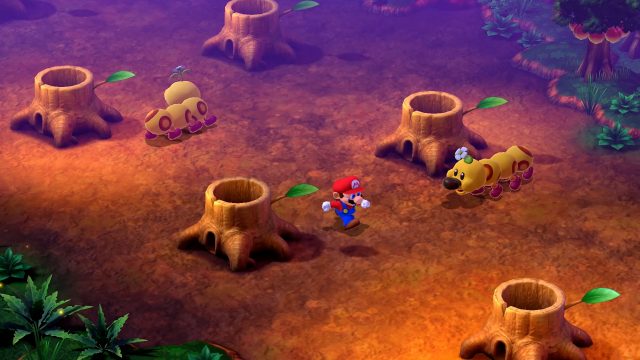The classic "action commands" combat systems remains as engaging as ever; revamped visuals are gorgeous; being able to switch between the original and rearranged soundtracks is a great concession for longtime fans; story is funny and genuinely engaging throughout; lots of compelling secrets to keep players coming back for more; new post-game content is solid
Some quirky control changes where some things can be customized but others seemingly arbitrarily cannot; some of the rearranged tracks don't match the vibe of the setting they're a part of
We’re trying something a wee bit different for our review of Super Mario RPG. Both Angela and I love the original SNES version of this game, so we’ve decided to combine forces and produce a joint review of the remake. We’re giving it a singular score, but you can read both of our reasonings for the grade in each of our reviews. And with that, find out what we thought of the new Super Mario RPG!
Robert’s Take
Written by Robert Marrujo
Super Mario RPG: Legend of the Seven Stars is a game that dominates my childhood gaming memories. There are a number of video games that had a strong impact on me growing up: Super Mario Bros. 3, Super Mario World, the Donkey Kong Country trilogy, and The Legend of Zelda: Ocarina of Time are standouts, all for different reasons. Super Mario RPG, however, is right up there among the favorite things I’ve ever played, so I had very high expectations for the remake on Nintendo Switch. Overall, I would say this is a highly faithful and strong adaptation of the source material, but there are a handful of changes that were made which dampen the experience ever so slightly.
Let’s get the basics about the game out of the way: this was Mario’s first RPG and sees the nominal hero embarking on a quest to restore Star Road, which had been shattered by the evil Smithy Gang. The villains have taken over Bowser’s castle, ousting the longtime antagonist and forcing an unusual alliance between the Koopa King, Mario, Princess Peach, and newcomers Geno (a doll being animated by a spirit from Star Road) and Mallow (a very confused “tadpole” on a journey to discover his origins). Combat is turn-based, and as players accumulate the missing seven stars they will take on hordes of foes to build up EXP and master new skills, all while accumulating a myriad of weapons, armor, and items to trick out the party of heroes.
For this remake, the majority of the experience between 1996 and now is largely unchanged. If you loved Super Mario RPG the first time around, odds are high that you’re going to enjoy it on Nintendo Switch, too. For newbies, the innovative combat system and charming story are likely to create a fresh generation of devotees. However, for longtime fans I will argue that some of the changes are very noticeable and might impact enjoyment to a degree, so that’s what I’m going to focus on here.
First off, for most people who have played games across multiple years, there are certain titles that produce muscle memory responses. For instance, I can load up Donkey Kong Country and largely play it on autopilot; I don’t have to think very hard as I run through stages, bopping baddies and launching from barrels. My hands know what to do and my mind almost takes a backseat as I play that game. Super Mario RPG is another title that I played so much that even small alterations to the control scheme stand out to me, and there are a couple here that left me slightly curmudgeon.
The Y button, for example, is no longer mapped to make Mario run, as it is now being used to pull up a submenu during gameplay. The game defaults Mario’s movement speed to running, which you can alter, but if you want to manually make the character either walk or sprint, players must now press down the L or R buttons. For the life of me I can’t figure out why the submenu tethered to Y wasn’t simply attached instead to either L and R or ZL and ZR. Or, perish the thought, allow players to manually map the buttons themselves or offer a control scheme that adhered exactly to the original game’s.
This wouldn’t seem like such a big deal if Nintendo didn’t offer other control options that made the gameplay skew more heavily towards the original game’s. Case in point: one control option maps the battle menu buttons exactly as they were on SNES. In Legend of the Seven Stars, player actions such as defend, special moves, and so on, are mapped to the controller’s face buttons. In the remake, once an action has been selected, B and A are used to either reject or confirm a command. On SNES, players would instead hit the same button that initiated an action. Meaning, hit X to pull up items, then hit X again to confirm, or one of the other face buttons to back out. This setting, for whatever reason, can be chosen on Switch, but the run button can’t be altered. So why cater to one aspect of the player’s memory and not the other? It’s a perplexing decision.
Similarly perplexing is the inability to turn off splash damage during battle sequences. Super Mario RPG’s combat system has a timing-based mechanism called action commands. Hit the attack button at the right moment and additional damage will be meted out to foes. In the remake, this mechanism is still in place, but an exclamation point will appear over the character prompting the player to hit A. It’s disappointing this can’t be outright shut off, but it does eventually disappear when the game senses that the player has the timing down. The larger problem, by my estimation, is the buff that action commands have been given.
In this version of Super Mario RPG, perfectly initiating an action command will send out a shockwave that damages all foes on the playing field. Although the damage is fairly minimal, it serves to speed up battles, allowing skilled players to rapidly dispatch enemies and move on to the next encounter. I can see many people being pleased by this, but in my experience what the change did was rush proceedings and make battles too easy. Even with the presence of some solid post-game content (let’s just say the game does eventually up the ante in battles) and the occasional super tough variants of enemies that randomly spawn on the battlefield, I still wished I could just turn splash damage off.
There are other tweaks to be found throughout this take on Super Mario RPG. The music has been given a fresh arrangement, which is serviceable but, frankly, nowhere near as compelling as the original tunes. Thankfully, players can switch between the original and rearranged soundtracks at will, so find the sound that suits your ears best. Some names of characters, attacks, and locations have also been altered for this remake, which only longtime fans might notice; I know I certainly did and felt rather glum about it, but the new names didn’t prevent me from enjoying myself.
Beyond name changes, the biggest refresh comes in the form of Super Mario RPG’s new visuals. The fresh coat of HD sheen and widescreen presentation looks great. Admittedly, some of the charm and uniqueness of the original’s prerendered graphics has been lost, but Super Mario RPG is nonetheless undeniably pretty on Switch. I did find, however, that the game would stutter a bit, from the opening cinematic of Mario approaching Bowser’s Keep, to other random times throughout the adventure. Given the SNES iteration of Super Mario RPG ran without a hitch, it’s disappointing to see the game lurching at all.
I’m leaning negative, it probably sounds like, but my gripes are really only being levied at the alterations, and even in that regard none of it is game-breaking. These changes have resulted in shortcomings that I find irksome, but I can admit that I think they bother me more because I’m so familiar with the first Super Mario RPG. Taking that into account, if you’re a stickler for the sort of things I’ve been grousing about, you might feel similar to me, but there’s no question that Super Mario RPG on Switch is a delight. The battle mechanics, story, and visual design are a treat and absolutely worthy of a retread or a first attempt by anyone who’s a fan of roleplaying games. 27 years later I am as thrilled by Super Mario RPG as I was when I was a kid—albeit with some small reservations.
Angela’s Take
Written by Angela Marrujo Fornaca
While I may feel more positive overall on the Super Mario RPG remake compared to Robert, I do share some of his frustrations and don’t think it’s quite perfect. However, setting aside my (very strong) feelings for the original game, which is perfection in my opinion, I think this remake was really solid overall.
The new graphics are charming and environments are genuinely beautiful. And because everything is so crisp and clear now, I found myself noticing details I never noticed in the original. For example, I never realized Mack (now Claymorton) was actually a little devil-looking guy hanging onto a giant sword—I just thought the enemy itself was a sword. Likewise, I also hadn’t recognized that Johnny is wearing a shark suit. These details add even more charm to an already quirky, cute, and strange world.
My only issue is that about midway through the game, I started to notice some stuttering visuals every now and then. When the stuttering happened it was brief and easy to miss, but the fact that it was happening at all was really frustrating to me. I’m no developer so I’m not going to say it should be easy to make sure a AAA remake of a classic game doesn’t have graphical stutter at release, but I would hope it would be prevented if at all possible.
While it’s true that the default button mapping has been changed from the original controls, this wasn’t an issue for me and didn’t confuse me. However, while it’s nice that Nintendo included the ability to switch to the original button layout (for the most part), it’s still not exactly right and doesn’t apply to non-combat controls. I do like some of the quality of life changes, like being able to use HP-healing abilities and items on the fly, rather than pressing start to scroll through menus. I also like being able to make Mario run by default, which is a feature I left on during my playthrough.
Like Robert, I felt like I was leveling up faster than in the original. After looking up some discussions online between other players to see if this was accurate, I saw someone mention that, in the original, every time a character leveled up one of the stat bonuses would be bigger than the others in an attempt to incentivize you to choose that stat bonus. In this remake, there are now two such stats with every level-up, which may be why we’re feeling like we’re leveling up faster. Because technically, we are.
For players who want more of a challenge, this may not be the best news. Nintendo tried to even things out by maintaining the “special” enemies that are tougher and harder to take out from the original Super Mario RPG. But if you battle and level up enough, eventually even those guys will start to feel like chumps. Additionally, the player now gets cues for when to press the attack button during battle to perform stronger versions of attacks. I think it’s alright, since some of the timing in the original was unclear, but at the same time learning that sometimes-weird timing was just part of the game’s challenge. So I have some mixed feelings about that change.
Triple Moves are very fun and satisfying to use, and it’s clear that the cutscenes of the characters attacking in unison are very inspired by many of the group Final Smashes in Super Smash Bros. Ultimate. And, as cool as they are, I’m also glad that a skip button was included to maintain the flow and pace of battle. I loved that different combinations of characters unlock new Triple Moves. There was a litany of changes made to the battle system alone, and I could go on and on about all of them. And while I may not love all of them, some are better than others, some are genuinely good, and they all come together to make this game its own unique experience that stands apart from the original.
That being said, I do take issue with some of the localization/translation changes that have been made from the original. I understand some of the changes were made to be more accurate to the original Japanese script, but some of them come across as incredibly generic and bland. Cinder Toad versus Hinopio, Claymorton versus Mack, Frogfucius versus Frog Sage. Mack in particular is believed to be a very interesting and clever reference to the jazz song Mack the Knife — certainly a little more interesting than a mere portmanteau of claymore and Morton.
I do wonder how many of these changes were made with “remade for modern audiences” in mind, which is a massive sticking point for me. One of the first things I noticed when this game was announced and some of the first gameplay footage was shown was that a certain, ah, exaggerated animation that Valentina had when she’s hit by an attack was removed for the remake. Do I personally need jiggle mechanics in my Mario games? No, but I also would rather not see something sanitized for no reason other than “it might offend someone.”
The music was the biggest disappointment for me with the Super Mario RPG remake. The original’s soundtrack is one of my all-time favorite game OSTs and, in my opinion, is one of the greatest ever. I very frequently find myself listening to tracks from that game. The new arrangements fail to capture the charm and personality of the originals and, in some cases, fail to match the environment in the way the old tracks did. Kero Sewers was an early example of this in my playthrough. The original track is foreboding, but it’s also got an eerie quietness about it, perfect for the dark, damp environment of the sewers. The remake’s rendition of the song is too grand, too loud, and too big, and doesn’t really match the overall vibe of the area. While I’d switch back to the new music for a brief moment whenever I entered a new place, just to hear the new versions compared to the old, I’d always switch back to the original score.
While it may seem like I have a lot of complaints for someone who started off saying I probably like the game more than Robert overall, I did genuinely enjoy this remake. I had a ton of fun with it, and it was so cool seeing one of my all-time favorite games back on the screen in a new and different way. I also made a conscious effort to try to not constantly compare the remake to the original, to give it the fair shake it deserves outside of the shadow of such a well-loved classic. But unfortunately for the remake, the original is a well-loved classic for a reason and it set an extremely high bar to try and reach, let alone surpass. And it’s honestly difficult to entirely separate the two games. While I loved the Super Mario RPG remake and would recommend that both long-time fans and newcomers play it, I can’t say that it quite met the bar its predecessor set.
And with that, our first Dual Review is at a close. Whose argument did you find yourself most drawn to? Or did you think both of us were off the mark? We’d love to hear your opinion about Super Mario RPG down in the comments!




 ShareThis
ShareThis